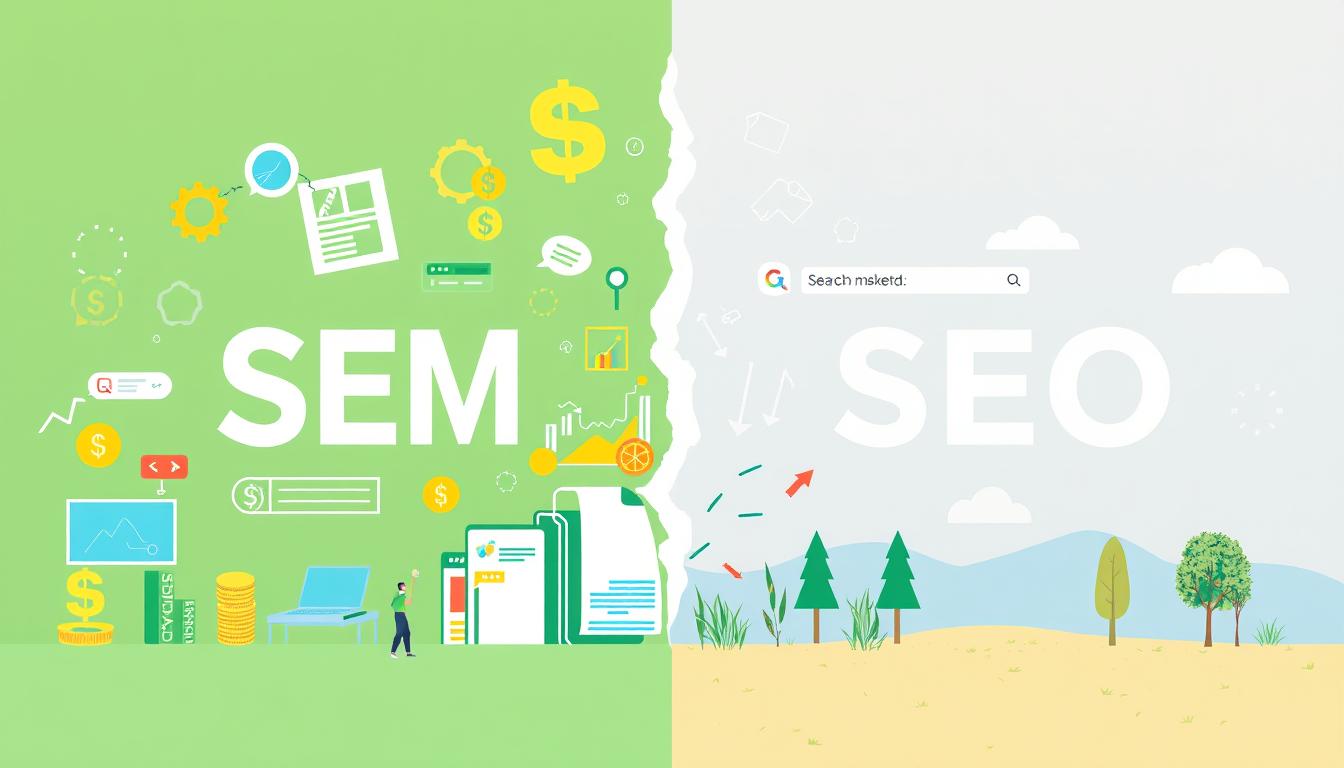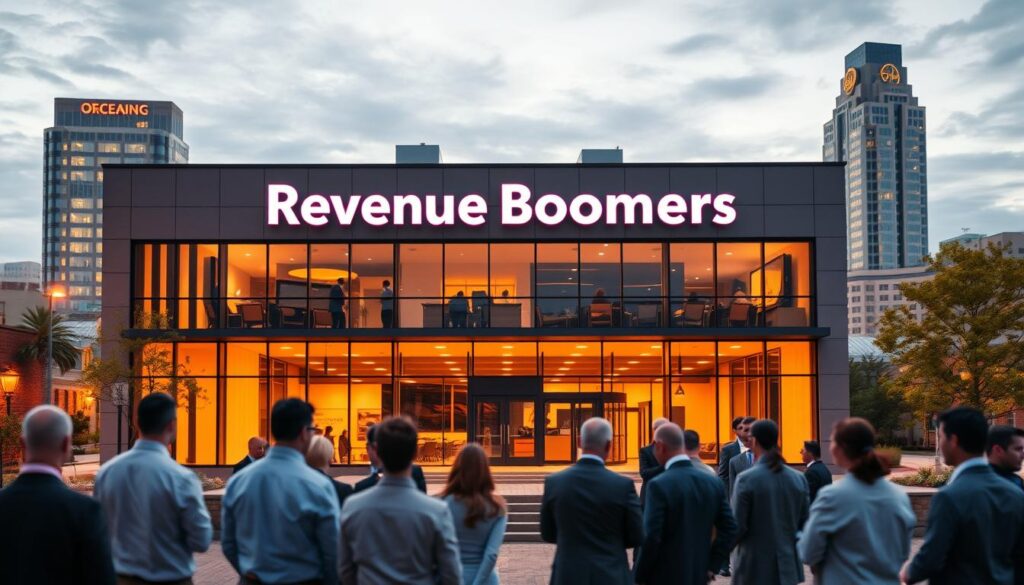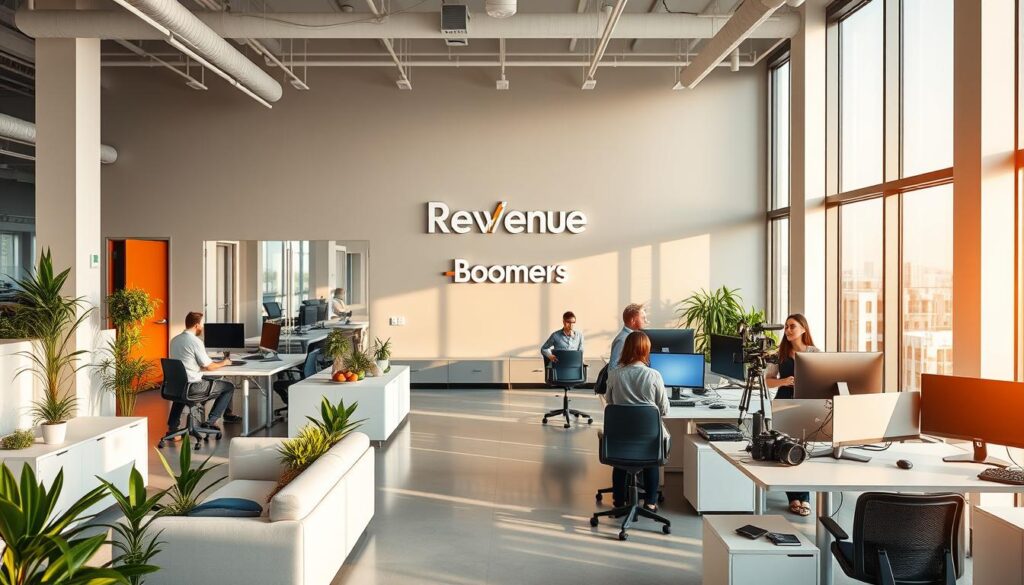Ever wondered why some websites are all over search results and others aren’t seen much? It’s because SEM and SEO marketing strategies are different. Knowing these differences is key. It shows businesses how to be more visible online. SEM (Search Engine Marketing) is a wide strategy. It includes paid ads and organic SEO (Search Engine Optimization) efforts. SEM gets you fast traffic with ads. But SEO is for the long run. It builds organic visitors over time. Understanding these strategies well can really boost your online presence. For more insights on SEM vs SEO, check out Backlinko.
Key Takeaways
- SEM involves paid advertising to improve search result visibility while SEO focuses on organic rankings.
- Both SEM and SEO strategies are essential for driving traffic, but they serve different purposes and timelines.
- SEO strategies enhance long-term authority and rankings, whereas SEM can deliver immediate traffic and results.
- Monitoring and managing costs in SEM is crucial for profitability, while SEO requires a focus on high-quality content and site architecture.
- Understanding your goals and resources is key to determining the best approach—SEM vs SEO marketing—for your business.
Defining SEO and Its Importance
SEO stands for Search Engine Optimization. It’s a key digital marketing strategy that boosts a website’s visibility in search results. By tweaking different parts of a website, companies can draw in quality, organic traffic. This improves their online presence by focusing on specific keywords. That’s why knowing the vital elements of SEO and how to use them is important.
What is SEO?
Search Engine Optimization aims to better a website’s position in search results. It uses various methods to make sites more appealing to search engines and users alike. It might take some months to two years to see big changes in ranking. But these changes last longer than the quick boosts from SEM, highlighting sem vs seo differences.
Key Components of SEO
The main parts of SEO include:
- Keyword Research: Finding what potential customers type when looking for products or services.
- On-Page Optimization: Making individual pages better by working on content and HTML source code.
- Off-Page Efforts: Using outside methods like backlink building to raise the website’s authority.
- Technical SEO: Ensuring the website’s setup allows search engines to index it, which helps it get found.
On-Page, Off-Page, and Technical SEO
Every SEO aspect is crucial for better search rankings:
| Type of SEO | Description | Examples |
|---|---|---|
| On-Page SEO | Makes webpage content and HTML better | Title tags, meta descriptions, right keyword use |
| Off-Page SEO | Includes outside factors affecting rankings | Backlinks, social media activity |
| Technical SEO | Keeps a site’s technical side fine-tuned for search engines | XML sitemaps, works well on mobile, secure |
Knowing these elements helps in forming strong SEO plans. These plans don’t just push up search rankings. They also make the user experience better, making sure visitors find useful content that matches their needs.
Understanding SEM and Its Scope
Effective digital marketing is key. It involves knowing SEM and SEO. SEM, or Search Engine Marketing, is broader than SEO. It uses both paid and organic methods to increase search engine visibility. Knowing the differences between SEM and SEO is vital for businesses wanting to grow online.
What is SEM?
SEM uses different strategies to promote websites through search engines. It includes pay-per-click (PPC) ads and SEO tactics. The aim of SEM is to draw in people who are actively searching, making them more likely to engage through targeted ads and top content. A big part of SEM is combining SEO with SEA (Search Engine Advertising), creating a well-rounded online strategy.
Difference Between SEM and SEO
The difference between SEM and SEO is important in digital marketing. SEO is all about organic search rankings without spending money. It depends on on-page SEO, off-page SEO, and technical optimization. SEM, however, adds paid methods to these organic strategies, offering a more complete solution.
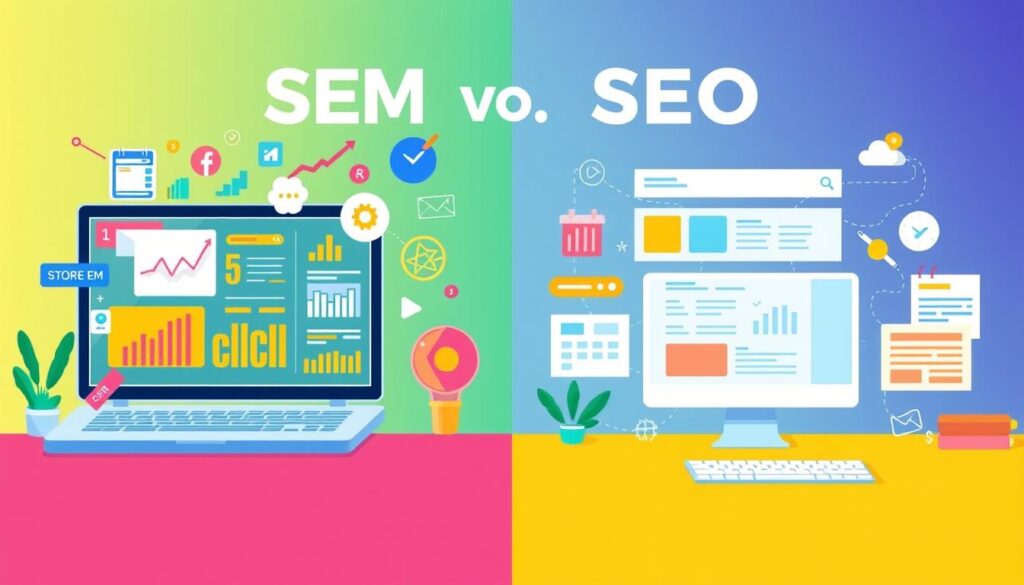
| Feature | SEM | SEO |
|---|---|---|
| Cost Structure | Paid ads, typically $500 to $10,000 monthly | Investment ranges from $50 to over $200 per hour |
| Time to Results | Visible outcomes within days to a week | Varies from weeks to months |
| Type of Traffic | Paid traffic through ads | Organic traffic through unpaid rankings |
| Credibility | Immediate visibility but lower organic trust | Long-term trust built through organic positioning |
| Strategy Focus | Short-term gains | Long-term growth |
Pairing SEM and SEO can be very effective. Understanding each and using them together can greatly increase a business’s online presence and traffic. Businesses can achieve the best results by using SEM and SEO wisely.
SEM vs SEO Marketing: Key Differences
Search Engine Marketing (SEM) and Search Engine Optimization (SEO) have unique strategies for attracting online traffic. Knowing the sem vs seo differences helps companies pick the right method for them. We’ll look at how they differ in traffic sources and costs.
Traffic Sources: Organic vs Paid
SEO aims to get organic traffic. It uses content marketing and technical improvements to boost site rankings in search results. Organic rankings grow over time, offering long-term visibility with ongoing upkeep. SEM, however, relies on paid strategies like Pay-Per-Click (PPC) ads for quick results. This approach gives immediate traffic and visibility, which is great for those looking for fast outcomes.
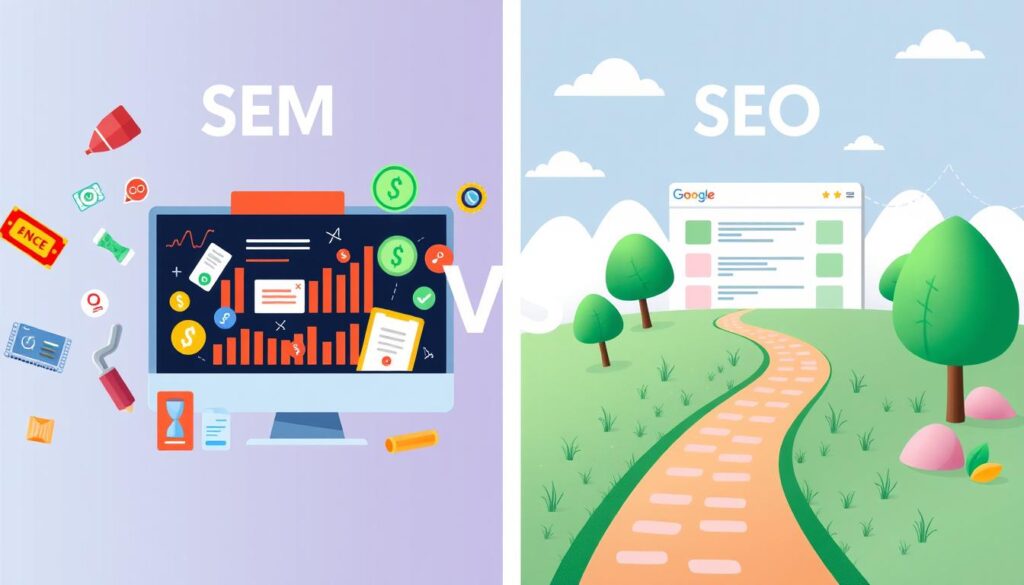
Cost Comparisons of SEO and SEM
Comparing the costs of SEO and SEM reveals some interesting points. SEO typically needs an upfront cost of $2,500 to $10,000+ a month. But it’s more cost-effective in the long haul. It can bring in an ROI of 175% on average, versus 100% from paid Google ads. SEM, though, has ongoing ad costs, which could end up costing more over time.
If you need quick visibility, sem vs seo advantages stand out. SEM offers swift returns with its tracking and analytics. This allows for faster evaluation of how well campaigns are doing. However, companies need to watch their budgets, as SEM needs continuous money flow.
Both SEO and SEM are great for increasing brand visibility. It’s vital to weigh the cost comparisons of seo and sem when picking a strategy. A clear understanding helps craft a marketing plan that meets both immediate and future needs.
For more information, delve into a comprehensive discussion on the differences between SEM and SEO.
The Speed of Results: SEM and SEO Timing
Choosing between SEM and SEO is key due to their result speeds. SEM shines with its fast effect, drawing businesses for quick traffic. For urgent promotions, launching a PPC campaign sees traffic in hours. This is a major plus.
Immediate Impact of SEM
SEM delivers quick, making it great for immediate needs. It allows for fast ad strategy changes, boosting visibility swiftly. In stiff competition, SEM’s speed is critical. Costs vary, but swift changes make the investment worth it. High click costs demand smart budgeting for good returns.
Long-Term Success with SEO
SEO, however, plays the long game, taking months or years for big traffic boosts. It builds your site’s authority and visibility slowly. Starting SEO takes time but leads to stable growth. SEO is cheaper over time compared to SEM’s costs. Mixing SEM’s quick wins with SEO’s steady growth gives the best results.
| Strategy | Time to Results | Cost Range | Conversion Rate |
|---|---|---|---|
| SEM | Hours to Days | $1,000 to $10,000/month | 1.3% |
| SEO | 6 to 12 Months | $500 to $5,000/month | 2.4% |
Learn more about how SEO works and its digital marketing role here.
Advantages and Disadvantages of SEM and SEO
Knowing the differences between sem vs seo advantages and sem vs seo disadvantages is key for companies aiming to boost their online presence. Both strategies offer unique pros and cons. These can greatly affect a business’s visibility online and the success of its marketing efforts.
Pros and Cons of SEO Strategies
SEO (Search Engine Optimization) improves a website’s organic ranking in search engine results pages (SERPs). This includes optimizing web pages, building links, researching keywords, and creating valuable content. The goal is for the site to appear in the top results for certain searches.
- Pros of SEO:
- It helps generate traffic sustainably over the long term.
- Organic results boost credibility, as users trust them more.
- It increases organic traffic gradually without ongoing costs.
- Cons of SEO:
- It can take time to see results from your efforts.
- Search engine updates can make outcomes uncertain.
- Technical knowledge is needed for implementation and adjustments.
Pros and Cons of SEM Strategies
SEM (Search Engine Marketing) uses paid ads to increase SERP visibility. It involves keyword research, creating ads, and monitoring their performance closely. This strategy is critical for executing effective SEM campaigns.
- Pros of SEM:
- It quickly boosts traffic, ideal for new launches.
- Allows for measurable ROI, making adjustments based on performance data easy.
- Targets ads precisely, ensuring they reach relevant people.
- Cons of SEM:
- Continuous investment can quickly deplete marketing budgets.
- Effectively managing campaigns requires learning new skills.
- Users might ignore ads if they see them too often.
By considering these points, companies can decide whether to invest in SEO or SEM strategies. Mixing both can lead to enhanced online visibility, improving marketing campaigns and impact overall.
Conclusion
Understanding the difference between SEM and SEO is key for businesses looking to improve online. SEM involves paid ads and organic searches, offering quick visibility. Meanwhile, SEO focuses on boosting organic search rankings through quality content, keyword optimization, and building backlinks. This builds lasting authority online.
Knowing when to use SEM and SEO is crucial for companies planning their digital marketing. SEM provides fast traffic but SEO brings long-term, sustainable benefits. Ideally, using both strategies can help achieve immediate goals and establish a strong presence in organic searches.
For companies navigating digital marketing, working with experts can make things easier. Agencies like Revenue Boomers offer valuable insights for SEM and SEO strategies. Getting a free SEO consultation can help optimize your online approach and succeed in the competitive digital world.

